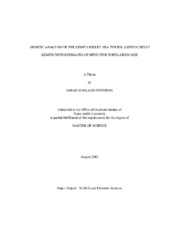| dc.contributor.advisor | Bremer, Jaime R. Alvarado | |
| dc.creator | Stephens, Sarah Holland | |
| dc.date.accessioned | 2004-09-30T01:46:42Z | |
| dc.date.available | 2004-09-30T01:46:42Z | |
| dc.date.created | 2003-08 | |
| dc.date.issued | 2004-09-30 | |
| dc.identifier.uri | https://hdl.handle.net/1969.1/220 | |
| dc.description.abstract | The critically endangered Kemp's ridley sea turtle experienced a dramatic decline in population size (demographic bottleneck) between 1947 and 1987 from 160,000 mature individuals to less than 5000. Demographic bottlenecks can cause genetic bottlenecks where significant losses of genetic diversity occur through genetic drift. The loss of genetic diversity can lower fitness through the random loss of adaptive alleles and through an increase in the expression of deleterious alleles.
Molecular genetic studies on endangered species require collecting tissue using non-invasive or minimally invasive techniques. Such sampling techniques are well developed for birds and mammals, but not for sea turtles. The first objective was to explore the relative success of several minimally invasive tissue-sampling methods as source of DNA from Kemp's ridley sea turtles. Tissue sampling techniques included; blood, cheek swabs, cloacal swabs, carapace scrapings, and a minimally invasive tissue biopsy of the hind flipper. Single copy nuclear DNA loci were PCR amplified with turtle-specific primers. Blood tissue provided the best DNA extractions. Additionally, archival plasma samples are shown to be good sources of DNA. However, when dealing with hatchlings or very small individuals in field situations, the tissue biopsy of the hind flipper is the preferred method.
This study's main focus was to evaluate whether the Kemp's ridley sea turtle sustained a measurable loss of genetic variation resulting from the demographic bottleneck. To achieve this goal, three alternative approaches were used to detect a reduction in Kemp's ridley's effective population size (Ne) from microsatellite data. These approaches were 1) Temporal change in allele frequencies, 2)An excess of heterozygotes in progeny, and 3)A mean ratio (M) of the number of alleles (k) to the range of allele size (r). DNA samples were obtained from Kemp's ridleys caught in the wild. PCR was used to amplify eight microsatellite loci and allele frequencies were determined. Data from only four microsatellites could be used. Although the reduced number of loci was a limiting factor in this study, the results of all three approaches suggest that Kemp's ridley sustained a measurable loss of genetic variation due to the demographic bottleneck. | en |
| dc.format.extent | 480755 bytes | en |
| dc.format.extent | 137134 bytes | en |
| dc.format.medium | electronic | en |
| dc.format.mimetype | application/pdf | |
| dc.format.mimetype | text/plain | |
| dc.language.iso | en_US | |
| dc.publisher | Texas A&M University | |
| dc.subject | Microsatellite | en |
| dc.subject | Kemp's ridley | en |
| dc.subject | Lepidochelys kempii | en |
| dc.subject | genetic | en |
| dc.subject | effective population size | en |
| dc.title | Genetic analysis of the Kemp's ridley sea turtle (Lepidochelys kempii) and estimates of effective population size | en |
| dc.type | Book | en |
| dc.type | Thesis | en |
| thesis.degree.department | Wildlife and Fisheries Sciences | en |
| thesis.degree.discipline | Wildlife and Fisheries Sciences | en |
| thesis.degree.grantor | Texas A&M University | en |
| thesis.degree.name | Master of Science | en |
| thesis.degree.level | Masters | en |
| dc.contributor.committeeMember | Fitzgerald, Lee A. | |
| dc.contributor.committeeMember | Landry, Andre M., Jr. | |
| dc.contributor.committeeMember | Dellapenna, Timothy | |
| dc.type.genre | Electronic Thesis | en |
| dc.type.material | text | en |
| dc.format.digitalOrigin | born digital | en |


